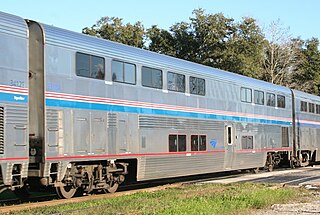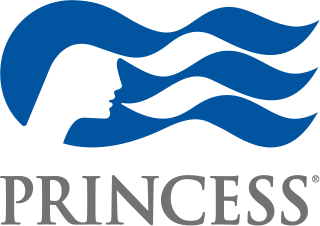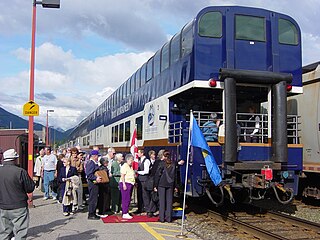
The Alaska Railroad is a Class II railroad which extends from Seward and Whittier, in the south of the state of Alaska, in the United States, to Fairbanks, and beyond to Eielson Air Force Base and Fort Wainwright in the interior of that state. Uniquely, it carries both freight and passengers throughout its system, including Denali National Park. The railroad has a mainline over 470 miles (760 km) long and is well over 500 miles (800 km) including branch lines and siding tracks. It is currently owned by the state of Alaska. The railroad is connected to the contiguous 48 via three rail barges that sail between the Port of Whittier, Alaska and Harbor Island in Seattle but does not currently have a direct, land-based connection with any other railroad lines on the North American network. In 2016, the company suffered a net loss of $4.3 million on revenues of $169.8 million, holding $1.1 billion in total assets.
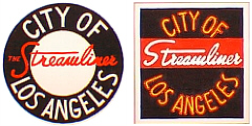
The City of Los Angeles was a streamlined passenger train between Chicago, Illinois, and Los Angeles, California via Omaha, Nebraska, and Ogden, Utah. Between Omaha and Los Angeles it ran on the Union Pacific Railroad; east of Omaha it ran on the Chicago and North Western Railway until October 1955 and on the Milwaukee Road thereafter. The train had number 103 westbound and number 104 eastbound.

A dome car is a type of railway passenger car that has a glass dome on the top of the car where passengers can ride and see in all directions around the train. It also can include features of a coach, lounge car, dining car, sleeping car or observation. Beginning in 1945, dome cars were primarily used in the United States and Canada, though a small number were constructed in Europe for Trans Europ Express service, and similar panorama cars are in service on Alpine tourist railways like the Bernina Express.

In rail transport, head-end power (HEP), also known as electric train supply (ETS) is the electrical power distribution system on a passenger train. The power source, usually a locomotive at the front or 'head' of a train, provides the electricity used for heating, lighting, electrical and other 'hotel' needs. The maritime equivalent is hotel electric power. A successful attempt by the London, Brighton and South Coast Railway in October 1881 to light the passenger car between London and Brighton heralded the beginning of using electricity to light trains in the world.
This article discusses transportation in the U.S. state of Alaska.

The Olympian and its successor the Olympian Hiawatha were passenger trains operated by the Chicago, Milwaukee, St. Paul and Pacific Railroad between Chicago and the Pacific Northwest. The Olympian operated from 1911 to 1947 and was, along with its running mate the Columbian, the first all-steel train to operate in the Pacific Northwest. The streamlined Olympian Hiawatha operated from 1947 to 1961 and was one of several Milwaukee Road trains to carry the name "Hiawatha." The Olympian Hiawatha was designed by industrial designer Brooks Stevens and included the distinctive glassed-in "Skytop" observation-sleeping cars. It later featured full-length "Super Dome" cars.
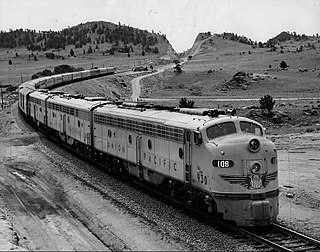
The Challengers were named passenger trains on the Union Pacific Railroad and the Chicago and North Western Railway. The economy service ran between Chicago, Illinois, and the West Coast of the United States. The trains had full Pullman service and coach seating and were an attempt to draw Depression-Era riders back to the rails. Food service was advertised as "three meals for under a dollar a day."
Colorado Railcar was a manufacturer of railroad rolling stock—railcars and diesel multiple unit commuter vehicles. Both products came in single- and double-level versions. It shut down in 2008, with its assets being purchased by US Railcar.

Dome Car Magic: A History of Railroad Dome Cars is a 2006 American television production that chronicles the history of the railroad sightseeing cars, from Burlington's 1945 Silver Dome to the full-length models operating today in Canada and Alaska.
The following is a list of sporting venues, events, and teams based in Alaska.

The Denali Star is a passenger and semi-luxury train operated by the Alaska Railroad between the cities of Anchorage and Fairbanks Alaska. It is a seasonal train, only operating between the months of May and September. The Aurora Winter Train operates along the similar route during the rest of the year at a less frequent weekend schedule. The train is ridden by many tourists visiting the Denali National Park. The train consists of single level coaches and dome cars.
The Aurora Winter Train, operated by the Alaska Railroad, provides passenger service between the cities of Anchorage and Fairbanks, Alaska. It is a seasonal train, only operating during the non-summer months. It is similar to the Hurricane Turn in that in addition to its scheduled stops it makes flag stops, making its schedule unpredictable. The northbound train operates on Saturdays, while the southbound train operates on Sundays.

Luxury trains are designed to offer a very comfortable ride and evoke an association with history and heritage. Operating in several countries, they are a premium travel option. Although some luxury trains promote tourism in destinations across a continent, others take passengers on a long, leisurely ride through a single country.
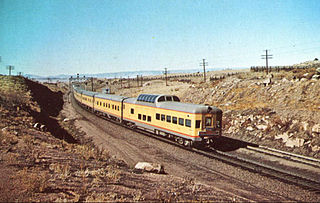
The Astra Domes were a fleet of streamlined dome cars built by the American Car and Foundry Company ("ACF") for the Union Pacific Railroad in 1954–1955. ACF built a total of 35 cars including coaches, dining cars, and observation cars. After the Union Pacific exited the passenger business in 1971 the Auto-Train Corporation purchased most of the fleet and operated them for an additional ten years.

The Single-Level Dome, also known as the Panorama Dome, is a type of dome coach manufactured by Colorado Railcar for various operators between 1997–2007. They are similar in concept to the company's bilevel Ultra Domes.


